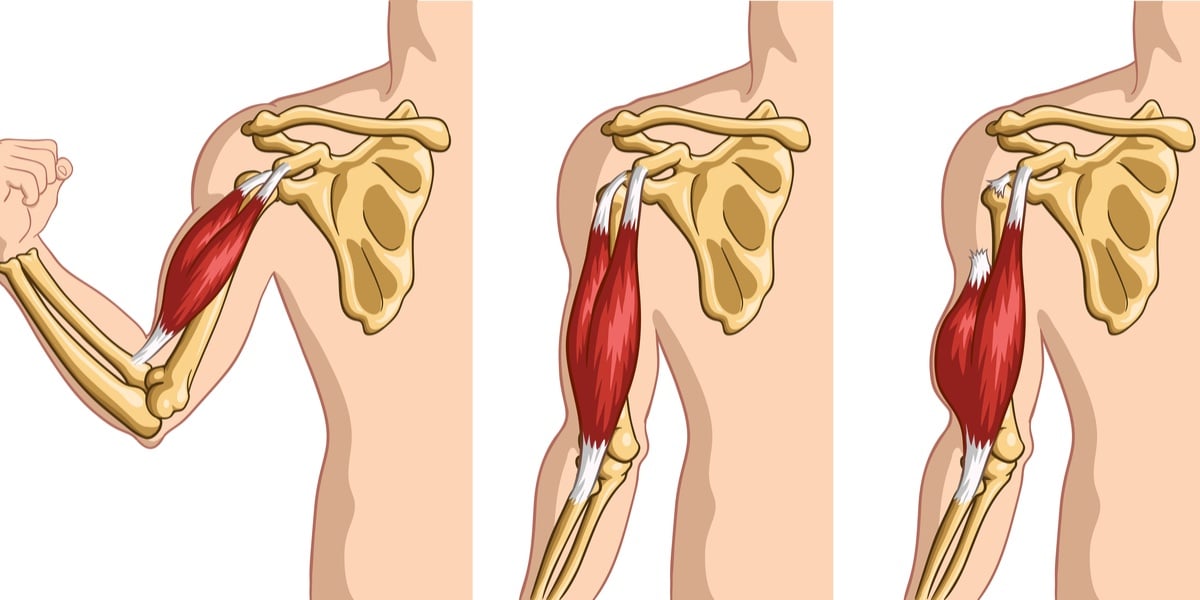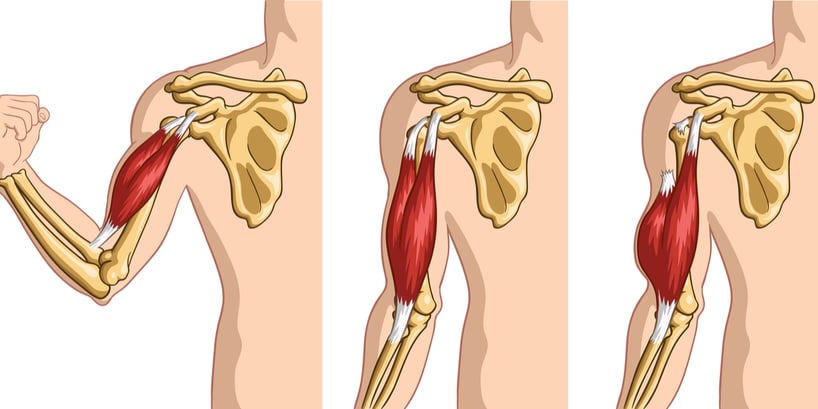Torn Biceps: Prevention and Treatment
October 16th, 2017 | 5 min. read


What Are Biceps Tears, Exactly?
Biceps tears and ruptures affect the biceps tendons that anchor the big muscle of your inner arm to your bones at the elbow and at the shoulder. They are either:
- Acute tendon injuries (usually from trying and failing to lift a heavy object); or
- Chronic tendon injuries: tears that happen gradually (usually the result of age-related wear and tear)
Shoulder biceps tears (also known as proximal biceps tendon tears) are far more common than elbow (distal biceps tendon), and chronic injuries (affecting adults over age 30) are more common than acute ones. Other causes and risk factors can include corticosteroid use, smoking, and a history of prior injuries.
Biceps tendon tears can be partial-thickness, or full-thickness. If you sustain a full rupture at either end of the biceps muscle, the muscle is then unattached at one end. Lacking one of its anchor points, the muscle may lose its tension and bunch up towards the middle of the upper arm. This will create an unnatural-looking bulge, often referred to as a 'popeye deformity', and bruising.
Biceps Tear Prevention Tips
If you’re weight-lifting, for example:
- Take reasonable measures to build up your strength gradually. If you can, work with a trainer to come up with a plan that gradually increases weight and reps.
- Avoid dead-lifts.
- Work with a trainer to make sure your form is correct. Check your posture as well.
- Train your entire upper body—not just the biceps. Strengthening your abs and back, for example, can help to protect your shoulders.
- Take rests between sets, and between workout sessions, as well. (Overtraining your muscles and tendons can lead to fatigue, tissue breakdown, and strain. Allow your tissue a chance to rebuild.)
- Stretch, warm up, and cool down.
If you’re participating in sports:
- Do all of the above.
- If you’re over 30, avoid dives, slides, and tackles that may put pressure on outstretched arms.
- If you’re over 30, be aware of the potential for overuse injury—especially when engaged in activities that rely heavily on the shoulder and upper arm, such as baseball pitching, swimming laps, or serving in tennis or volleyball. Talk to a coach or physical therapist about ways to protect your shoulders, arms, and tendons from repetitive strain.
If you’re over 30 (regardless of your activities):
- Know that your tendons are susceptible to age-related wear and tear. Collagen breaks down as we get older, causing tendons to fray. Awareness of this fact is the first step in avoiding injury.
- Don’t lift heavy objects. Past age 30, you’re simply more vulnerable to tendons strains and tears. Don’t be a hero and lift an overly heavy couch or moving box. Be especially mindful not to hoist very heavy items above the level of your shoulders. Dropping something heavy, then fumbling and trying to catch it, can lead to an acute biceps rupture.
- Don’t smoke. Scientists have found a link between smoking and musculoskeletal injuries, especially tendinitis. Smoking also inhibits healing by preventing oxygen from getting to bones and tissue.
- Go easy on the corticosteroid injections. If you have prior soft tissue injuries, particularly in the tendons, you may have had these treatments to help reduce swelling and promote healing. Too many injections in a single year can actually harm tissue rather than heal it. If you go overboard, you may be more susceptible to tendon rupture.
Men are far more likely to strain their biceps tendons than women. If you’re male and over the age of 30, be doubly mindful of the above cautions.
Treating a Torn Biceps
If you suspect a torn biceps, the first thing you need to do is visit a doctor for a diagnosis. Your doctor (preferably an orthopedist) will need to use an imaging test like an MRI to confirm a tear or rupture, although an X-ray may also be needed to rule out any injury to bone.
If you don’t have an obvious muscle bulge from a rupture, but are presenting with pain and difficulty using your arm, an X-ray may be first test your orthopedic physician uses. He or she will want to make sure you haven’t sustained a fracture.
Once you’ve had a diagnosis, options for treating a biceps tear include non-surgical treatment or surgical repair.
Non-surgical Treatment
If you have a tear at the shoulder and the subsequent pain and reduced mobility are not severe (or they don’t bother you much), your orthopedist may say you have the option of non-surgical repair.
In this case, you’re essentially allowing the body to heal itself with the help of rest and other techniques like:
- ice packs (cold therapy)
- NSAIDs to reduce inflammation; and
- physical therapy to strengthen your arm and keep your arm and shoulder joint flexible
Your physician may also recommend immobilizing the shoulder and upper arm during your recovery—for example, with a sling—to sustain further damage to the tissue.
Always see a physician before deciding to use a sling. A doctor can show you the correct angle to hold your arm and can provide guidelines as to how tight the sling should be and how many hours per day you should be wearing the support device.
Surgical Treatment and Repair
If your biceps tear is near the shoulder, it has more than one attachment point; therefore, unless you’ve severely torn all those tendons, you may not need surgery (elbow tears, on the other hand, are more likely to need surgical intervention).
The decision to surgically repair a torn biceps tendon depends largely on your personal tolerance for discomfort, arm weakness, deformity, and loss of range of motion. If you’re an athlete, you may be more likely to choose the surgical option so you can continue to participate in your sport. Likewise, if your job depends on full strength in your arm, surgery may be helpful.
However, if you’re an older adult (for example, past age 60), you may find you’re fine with reduced function in the arm. Keep in mind, however, that most surgeries are now minimally invasive and require only local anesthetic. Your recovery and rehab will take some time, but the surgery itself carries minimal risk and the outcomes are generally good.
What surgical procedures are available for repairing a torn biceps?
- For ruptures and tears at the elbow: A surgeon may need to pull the biceps muscle back down to the elbow, then reattach the biceps tendon to the forearm bone (radius) by drilling small holes in the bone. The surgeon may then use a stitching technique to secure the tissue. Another surgical reattachment option is to use metal anchors. Surgical outcomes are generally good, restoring full range of motion. You may have a minimal risk of re-rupture in the future, but the prognosis for most people is excellent, especially if you adjust your activities and go easier on the affected arm.
- For ruptures and tears at the shoulder: For partial tendon tears, arthroscopic surgery, involving tiny incisions and a camera, is the best way to work within the shoulder. Tendons often can be repaired with a suturing technique. In the case of full tears of the long head biceps tendon—where the tendon pulls completely off the bone—an open surgery may be necessary to reattach the tendon to the bone of the upper arm (the humerus).
Regardless of how you intend to treat your tear or rupture, you should make an appointment to see a physician as soon as you suspect an injury—especially if you’re physically active. Letting a serious biceps tear go untreated for too long can lead to other musculoskeletal issues as you try to compensate for the pain and weakness in your arm.
If you feel that you need to be evaluated for a biceps tear contact Coastal Orthopedics in Corpus Christi, Texas today at (361) 994-1166.
Article written by: Rob Williams, MD
Dr. Williams has been practicing orthopedic surgery in Corpus Christi since 1998. After graduating from Texas Tech hereceived his medical degree from the University of Texas at San Antonio. At the prestigious Campbell Clinic located at the University of Tennessee, Dr. Williams completed not only an Orthopedic Surgery Residency, but an additional year of Fellowship Training in Spine Surgery. Dr. Williams is dedicated to creating an excellent patient experience in the office or in the surgery suite.
Topics:


